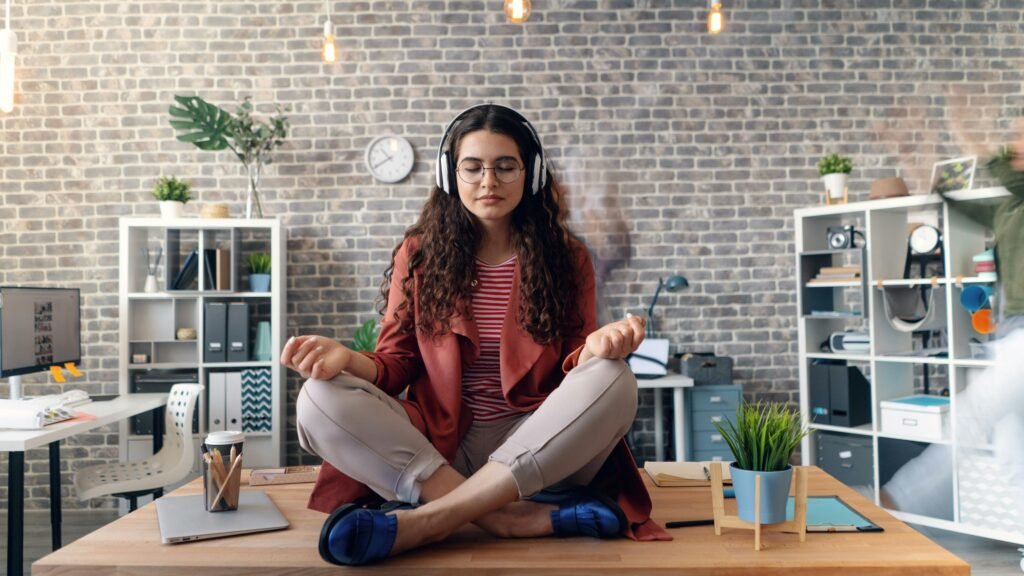
Introduction to Mindfulness
In our modern work environment, where the pace is relentless and demands are high, finding moments to pause and center ourselves is essential.
Mindfulness is a practice that brings our focus back to the present, allowing us to break free from the constant cycle of stress and distraction.
By integrating brief, effective mindfulness routines into your workday, you can cultivate a sense of calm and clarity that benefits both your mental and physical health.
Mindfulness isn’t just about sitting still and meditating for long periods; it can be seamlessly incorporated into your day, even during the busiest moments.
Simple exercises such as deep breathing, body scan meditations, mindful walking, gratitude journaling, visualization techniques, and mindful eating can be done in as little as five minutes.
These practices serve as quick but powerful tools to help you manage stress and refocus your mind.
Imagine taking a moment at your desk to practice deep breathing.
You inhale deeply, feeling the air fill your lungs, hold it, and then slowly exhale, releasing the tension in your body.
This act alone can bring a sense of immediate relief and help you return to your tasks with a renewed sense of calm.
Similarly, a quick body scan meditation can enhance your awareness and help you identify and release areas of tension you might not have noticed before.
By methodically checking in with different parts of your body, you not only foster relaxation but also become more attuned to your physical well being.
Mindfulness also extends beyond stillness.
Consider mindful walking, where you focus on the sensation of your feet against the ground and the rhythm of your steps.
This brief activity can break the monotony of desk work and refresh your mind.
Gratitude journaling offers another simple yet effective mindfulness exercise.
By taking a moment to write down things you are thankful for, you shift your focus from stress to positivity.
This small practice can enhance your overall mood and outlook, making it easier to tackle your tasks.
Visualization techniques can transport you to a serene place, providing a mental escape from the pressures of the office.
Envisioning a peaceful setting can lower stress levels and improve your mental state, even if just for a few minutes.
Lastly, mindful eating transforms a routine snack into an opportunity for mindfulness.
By savoring each bite and fully engaging your senses, you can enhance your enjoyment and bring a sense of mindfulness into your mealtime.
Integrating these practices into your day not only enhances your productivity but also supports your overall well being, making your workday more manageable and enjoyable.
Deep Breathing Exercises

Deep breathing exercises offer a straightforward yet effective way to bring calm and reduce stress during a busy workday.
By concentrating on your breath, you can divert your attention from daily pressures and bring yourself back to the present moment.
One popular technique to try is the “4-7-8” method.
Begin by inhaling deeply through your nose for a count of four seconds.
Hold your breath for seven seconds, allowing your body to absorb the oxygen fully.
Then, exhale slowly through your mouth for a count of eight seconds, letting go of any tension.
Repeat this cycle several times, and you will likely feel a noticeable sense of calm wash over you.
Another technique you can practice is diaphragmatic breathing, also known as belly breathing.
Sit comfortably with your back straight and place one hand on your chest and the other on your abdomen.
Take a slow, deep breath in through your nose, ensuring your abdomen rises more than your chest.
Exhale gently through your mouth, feeling your abdomen fall.
This method engages the diaphragm and promotes a deeper, more relaxing breath.
For a different approach, try alternating nostril breathing.
Sit comfortably and use your right thumb to close your right nostril.
Inhale deeply through your left nostril.
Close your left nostril with your right ring finger and release your thumb from your right nostril.
Exhale through the right nostril. Inhale again through the right nostril, close it with your thumb, and release your left nostril, exhaling through the left.
Continue this alternating pattern for a few cycles.
This practice can help balance the mind and promote a sense of calm.
Lastly, if you find yourself in a particularly stressful moment, the box breathing method can be a helpful tool.
This involves inhaling for four seconds, holding the breath for four seconds, exhaling for four seconds, and holding the breath again for four seconds.
Repeating this method a few times can bring immediate relief and help you regain focus.
Incorporating these breathing exercises into your daily routine can significantly improve your mental clarity and overall well-being, making your workday more manageable.
Body Scan Meditation

A body scan meditation offers an excellent way to tune into your physical sensations and promote relaxation.
Begin by finding a quiet, comfortable space to sit or lie down.
Close your eyes and take a few deep breaths to settle in.
Start by directing your attention to your toes. Notice any sensations; tingling, warmth, coolness, or tension. Without trying to change anything, simply observe what you feel.
Gradually move your focus up through your feet, ankles, and calves.
Pay attention to how these areas feel, noting any pressure or discomfort.
If you notice tension, visualize it melting away with each breath.
Continue this journey up your body, bringing awareness to your knees, thighs, and hips.
Take your time with each area, allowing yourself to fully experience any sensations.
This practice not only promotes relaxation but also enhances your connection to your body.
As you reach your abdomen, notice the rise and fall of your breath.
Feel the natural movement of your body as you inhale and exhale.
This connection to your breath can deepen your state of mindfulness and provide a calming effect.
Move your attention up to your chest, shoulders, and neck.
These areas often hold a lot of tension, especially after long hours of desk work.
Notice if your shoulders are hunched or if there is any tightness.
Visualize these areas softening and releasing tension with each breath.
Next, focus on your arms, moving from your upper arms down to your fingertips.
Notice any sensations along the way, and allow yourself to be present with each part of your body.
Finally, bring your attention to your face and head.
Notice if you are clenching your jaw or if there is tightness around your eyes or forehead.
Allow these areas to relax, letting go of any stress or strain.
Throughout this process, if your mind starts to wander, gently bring your focus back to the part of the body you were observing.
This practice helps train your mind to stay present and attentive.
By integrating body scan meditation into your workday, you can foster a greater sense of body awareness and promote overall well being.
Mindful Walking

Mindful walking is a dynamic mindfulness practice that can break the monotony of sitting at your desk while reinvigorating your mind and body.
To get started, simply stand up and take a few deep breaths to center yourself.
Begin to walk slowly and deliberately, paying close attention to the sensations in your feet and legs.
Feel the contact between your feet and the ground, noticing the texture of the floor beneath you.
This heightened awareness helps ground you in the present moment.
As you continue walking, try to synchronize your breath with your steps.
For example, inhale for two steps and exhale for two steps.
This rhythmic pattern can help you maintain focus and promote a sense of calm.
As thoughts inevitably arise, gently guide your attention back to the act of walking and breathing.
Notice your surroundings without judgment.
Observe the colors, shapes, and textures around you.
Perhaps there’s a window with sunlight streaming through or the subtle hum of office machinery in the background.
These observations can further anchor you in the present, allowing you to fully experience the moment.
Mindful walking doesn’t require a large space or a long duration.
Even a few minutes of slow, conscious walking around your office can have a profound impact on your mental state.
If you have the opportunity, take your mindful walk outside.
The fresh air and natural environment can enhance the practice, making it even more refreshing.
Another approach is to practice walking meditation, where the focus is solely on the movement and sensation of walking.
Start by walking in a small, defined area, such as a hallway or a designated path.
Walk at a slower pace than usual, and with each step, bring your attention to the lifting, moving, and placing of your foot.
This detailed focus can deepen your mindfulness and create a more meditative experience.
Mindful walking can also be an opportunity for a brief mental reset during a particularly stressful day.
If you find yourself overwhelmed, step away from your desk and take a short, mindful walk. This simple act can help clear your mind, reduce stress, and improve your overall well-being.
By integrating mindful walking into your daily routine, you can create small pockets of tranquility that contribute to a more balanced and productive workday.
Gratitude Journaling

Gratitude journaling can be an incredibly impactful practice, even when integrated into the busiest of workdays.
By setting aside just a few minutes to reflect on and document what you’re thankful for, you can shift your mindset toward positivity, fostering a sense of well being that permeates your entire day.
Begin by finding a quiet moment during a break.
Whether you use a traditional journal or a digital app, the act of writing things down can help solidify your thoughts and create a more profound sense of gratitude.
Start by jotting down three to five things you’re grateful for.
These can be big or small, from achieving a significant milestone in a project to simply enjoying a perfectly brewed cup of coffee. The key is to be specific.
Instead of writing, “I’m grateful for my job,” consider noting, “I’m grateful for the opportunity to work on a creative project that excites me.”
This specificity can make the exercise more meaningful and impactful.
Another approach is to focus on people you appreciate.
Write down the names of colleagues who have supported you, friends who have been there through thick and thin, or family members who bring joy to your life.
Reflect on why you’re grateful for them and how they contribute to your happiness.
This can not only improve your mood but also enhance your relationships by fostering a sense of connection and appreciation.
You might also consider themes for your gratitude entries.
For instance, on one day, you could focus on professional achievements, while on another, you might reflect on personal joys.
This variety can keep the practice fresh and engaging, encouraging you to look for the silver linings in different aspects of your life.
Incorporating imagery into your gratitude journal can further deepen the experience.
Attach photos, draw small illustrations, or include mementos that represent the things you’re grateful for.
This creative element can make the practice more enjoyable and visually uplifting.
Gratitude journaling is more than just a feel-good exercise; it’s a powerful tool for fostering a positive mindset.
As you cultivate this habit, you’ll likely find yourself more resilient and better equipped to handle the demands of your busy workday.
Visualization Techniques

Visualization is a powerful mindfulness technique that can help set a positive mindset and relieve stress.
Close your eyes and imagine a serene place, such as a quiet beach or a lush forest.
Picture the colors, sounds, and smells of this environment. This mental escape can help you return to work feeling refreshed and focused.
Visualization techniques can be as simple or as detailed as you prefer.
Start by choosing a peaceful setting that resonates with you.
Maybe it’s a tranquil mountain meadow, a cozy cabin by a lake, or a blooming garden.
Engage all your senses in the visualization; imagine the gentle rustle of leaves, the soft scent of flowers, or the warm sunlight on your skin.
To deepen the practice, you can create a mental story around your chosen scene.
Imagine walking through this place, exploring its beauty.
Feel the ground beneath your feet, hear the birds singing, and notice the intricate details around you.
This narrative approach can make the visualization more immersive and effective.
Another method involves visualizing your goals and aspirations.
Close your eyes and picture yourself achieving a significant milestone or successfully completing a project.
Visualize the steps you took to get there and the positive emotions associated with your success.
This can boost your motivation and provide a clear mental roadmap to follow.
You can also incorporate guided imagery, where a recorded voice leads you through a relaxing scenario.
Many apps and online resources offer guided visualization sessions tailored to various needs, such as stress relief or enhanced focus.
Whether you’re using a peaceful nature scene or visualizing your personal achievements, the key is to fully immerse yourself in the experience.
Allow your mind to wander through this tranquil space, giving yourself a few moments of mental clarity and relaxation.
Visualization can be a versatile tool to enhance your mindfulness practice and bring a sense of calm and focus to your busy workday.
Mindful Eating

Mindful eating is a simple yet powerful way to integrate mindfulness into your day.
It begins with selecting your food and extends to every bite you take.
Start by choosing a snack or meal that you enjoy and take a moment to appreciate its appearance.
Notice the colors, shapes, and textures of the food in front of you.
As you take your first bite, focus on the sensation of the food in your mouth.
Pay attention to the flavors, the texture, and how it feels as you chew.
Try to identify different tastes and textures, savoring each bite slowly.
By doing this, you create a deeper connection with the act of eating, turning it into a more engaging and pleasurable experience.
Engage all your senses; how does the food smell? What sounds do you hear as you chew?
These small details can make the act of eating more fulfilling and enjoyable.
By concentrating on the sensory experience, you allow yourself to fully immerse in the present moment, reducing distractions and stress.
Additionally, try to eat without multitasking.
Set aside your phone, close your laptop, and step away from your desk if possible.
This dedicated time for mindful eating can serve as a mental break, helping you reset and recharge for the rest of your workday.
Mindful eating also promotes better digestion and can help you recognize your body’s hunger and fullness cues more accurately.
This can lead to healthier eating habits and improved overall well-being.
If you have limited time, even a few mindful bites can make a difference. Start small and gradually extend the practice to entire meals as you become more comfortable.
By transforming your snack or meal into an opportunity for mindfulness, you can enhance your appreciation for your food and return to work feeling more grounded and focused.
Integrating mindful eating into your routine is an easy yet effective way to practice mindfulness, supporting both your mental clarity and overall well being.
